Putin and Global Health: Friend or Foe?
J. Stephen Morrison and Judyth Twigg. "Putin and Global Health: Friend or Foe?." CSIS Commission on Strengthening America's Health Security, Center for Strategic and International Studies, September 06, 2019. Accessed December 21, 2023. https://healthsecurity.csis.org/articles/putin-and-global-health-friend-or-foe/
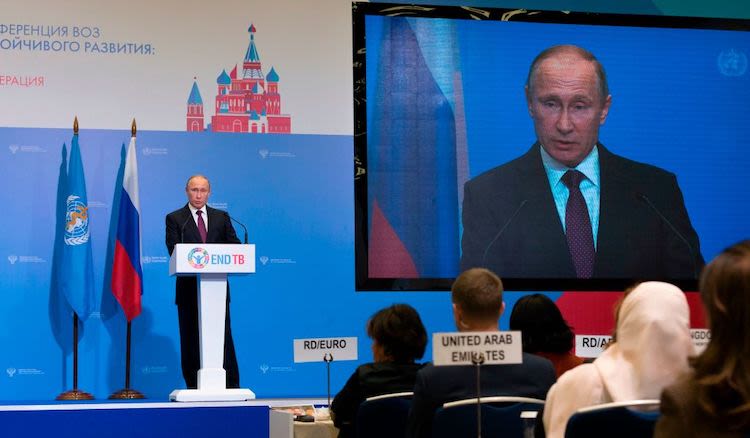
The Issue
Over the course of this decade, Russia has consciously enlarged its engagement and commitments, at home and in the wider world, in battling both tuberculosis (TB) and non-communicable diseases (NCDs). Despite these positive steps, Russia remains a serious global health security threat. There is a live risk of uncontrolled HIV/AIDS and drug-resistant tuberculosis (DR-TB) epidemics within Russia itself, as well as ongoing risk of export to neighbors in Eastern Europe and Central Asia, whose deep interdependence with Russia, including extensive migrant traffic, creates acute vulnerabilities. Beyond Eurasia, Russia stands out as one of several flashpoints in the world that could contribute to a resurgent HIV/AIDS and DR-TB epidemic that reverses the global gains of the past 15 years. Russia’s social media practices deliberately spread confusion and distrust surrounding a wide range of preventive health measures, ranging from vaccines to harm reduction. This analysis weighs Russia’s positive contributions against its multiple destructive actions in global health, examines what the overall pattern of Russian behavior means for U.S. policy, and concludes with a proposal for an expanded U.S. health security alliance with Eastern Europe and Central Asia. It argues that the United States should welcome Russian contributions and collaborate with serious Russian partners in the service of broader shared health goals. At the end of the day, however, Russia will only earn a legitimate global health leadership seat through progressive, evidence-based policies and actions, which can never be wholly segregated from the noise created by its geopolitically destabilizing actions.
Russia Poses Two Questions
Russia’s activism in responding to TB and NCDs has achieved concrete improvements in the health of the Russian population, enhanced Russia’s international profile, and added spark to the international TB and NCD agendas. More recently, Russia’s keenness to take up these important global causes fills a gap: it comes at a particularly uncertain moment as Washington, London, and some parts of Europe have taken an inward and more populist-nationalist turn. To varying degrees, some Western leaders have become openly skeptical of concerted multilateralism and liberal international norms, call for cuts in foreign aid, and often appear in retreat, disoriented by their own internal dramas and the weakening of established alliances. While they have not entirely withdrawn from leadership in global health, it is an open question whether they can be relied upon to advance the agenda into the future.
Russia’s new ambitions and achievements on TB and NCDs are to be welcomed and respected. These positive health ventures have, quite jarringly and visibly, collided with Russia’s intensified internal crackdowns, its outlier status on HIV/AIDS, and its accelerated assault upon the West and states like Ukraine and Georgia that have aspired to closer alignment with the West. Russia’s successive antagonistic actions have become the dominant story line in the media, superseding any modest reputational gains from its TB and NCD activism. This includes the 2014 occupation of Crimea; intervention into Ukraine’s eastern Donbass region; culpability in the July 2014 downing of MH-17 over Ukraine; the deliberate use of nerve agents in the United Kingdom; and Russia’s unbroken complicity in Assad’s use of chemical weapons against Syrian civilians. Moreover, the Mueller Report definitively catalogued Russia’s expansive, systematic assault on the U.S. elections in 2016, including its efforts to suborn the Trump campaign and weaponize U.S. social media.
The escalating confrontation between Russia and the West has given rise to a mountain of U.S. and international sanctions now in force against Russia, drastically limiting the scope of U.S.-Russian interactions. At the same time, the revised U.S. National Security Strategy, issued at the end of 2017, designates Russia, along with China, as the top-line strategic threat to U.S. national interests. Global terrorism has somewhat receded from view, as a new Cold War has stepped to center stage.
These complex developments pose two questions for U.S. policy.
First, what are we to make of Russia’s recent expanded engagement in global health? Is it important, sustainable, and impactful? Does it meaningfully fill gaps created by the retreat of the United States and other Western donors, particularly in areas like NCDs, where the United States and others are reluctant to move? Or is Russia’s activism of minor importance in the bigger picture of its widescale and increasingly aggressive behavior?
Second, what might this mean for U.S. policy? Are there still worthy opportunities for U.S.-Russia cooperation in scientific research and development, health security, and infectious diseases—including support of those Russian-led, -staffed, and -financed efforts in the World Health Organization (WHO) and elsewhere? Conversely, should the United States heighten its engagement in Eastern Europe and Central Asia in ways that counter Russian influence in these sensitive geopolitical zones while enhancing the health, wellbeing, and security of these populations?
Russia Takes Center Stage on TB and Chronic Diseases
Russia’s recent achievements in both NCDs and TB, globally and at home, are undeniably impressive. Heart disease mortality within Russia declined by 25 percent between 2005 and 2013, and it continues to fall, at least in part due to the implementation of best-practice policies restricting alcohol and tobacco sales, advertising, and use, as well as improved health care.[^1] On the global scene, Russia’s NCD contributions have taken a page straight from Putin’s broader foreign and security policy playbook—manage resource scarcity by leveraging relatively small investments for maximum, visible gain. Russia has become a prolific host of high-level international health meetings, starting in 2011 with the First Global Ministerial Conference on Healthy Lifestyles and NCD Control in Moscow. Putin received praise for his opening remarks, saying he “didn’t know a nobler mission” than the fight against NCDs. Russia was instrumental in establishing the WHO-led Interagency Task Force on the Prevention and Control of NCDs in 2013. Over the last three years, with Russian and Japanese government funding, the Task Force has undertaken dozens of missions to countries all over the world designing tailor-made national business cases for multisectoral investments in NCDs.
Figure 1[^2][^3][^4]
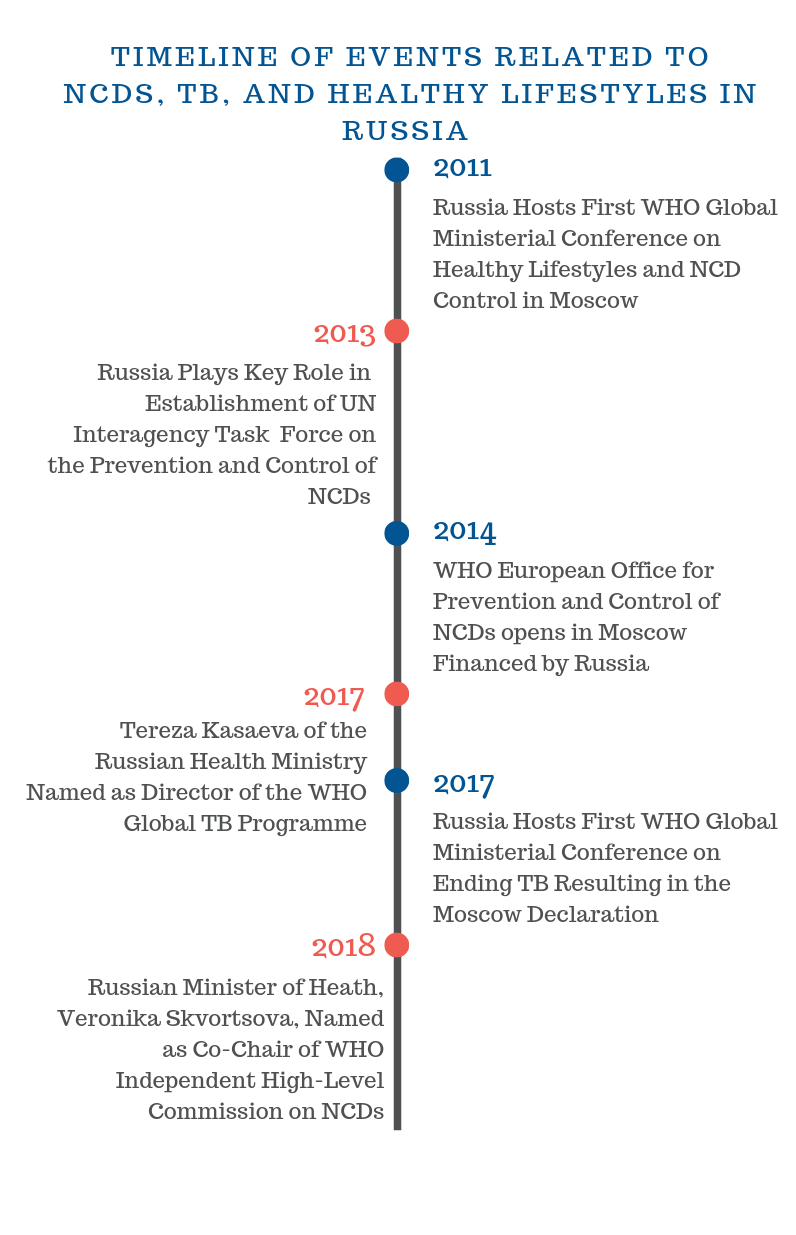
The WHO European Office for the Prevention and Control of NCDs opened in Moscow in 2014, financed entirely by Russia. The initial five-year investment for that office was only $20 million, but with global funding for NCDs so low overall, even that small amount has been gratefully received. Russian Minister of Health Veronika Skvortsova was one of five co-chairs of the 2017-2018 WHO Independent High-Level Commission on NCDs, and her influence clearly extended to Russia’s prominent voice at the September 2018 High-Level Meeting on NCDs in New York. Moscow-based global workshops on various aspects of NCDs—such as implementation research and surveillance—occur on nearly a monthly basis and are well-attended, often generating exposure for young Russian scientists and specialists. Not insignificantly, billions of viewers witnessed Russia’s successful hosting of the 2014 Olympics and 2018 World Cup, boosting the country’s image as a hub of athletics and fitness.
Figure 2[^5]
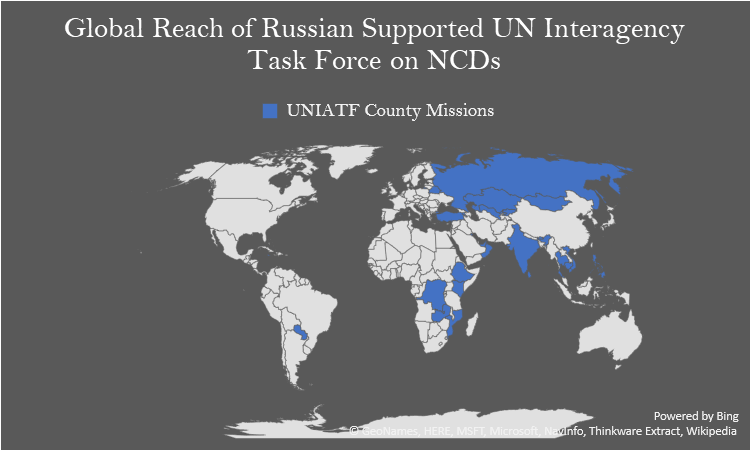
Over the last 10 years, TB incidence within Russia has dropped by over 40 percent, and the mortality rate by over 60 percent.[^6] This success rests, in part, on concerted international support from the Global Fund to Fight AIDS, Tuberculosis and Malaria, World Bank, WHO, and key non-governmental players like Partners in Health. Even more so, it is attributable to skillful political leadership from the Russian Ministry of Health and the former Russia TB program head, now leading WHO’s Global TB Program, Tereza Kasaeva. At the Russia-hosted November 2017 Global Ministerial Conference for Ending TB, which concluded with the Moscow Declaration to End TB, Putin again lent his voice to global health by pledging $15 million through 2020 for Russia-WHO cooperation in the global TB fight. Russia is the only country on WHO’s list of top-20 high-burden countries that completely funds its own TB response, giving it a unique claim to global leadership. While Kasaeva’s 2017 WHO appointment generated questions over the transparency of the selection process and whether it validates Russia’s otherwise poor record on health, she has since gained considerable respect on the job, particularly in terms of advocacy, political mobilization, and work with civil society and the media.
Figure 3[^7]
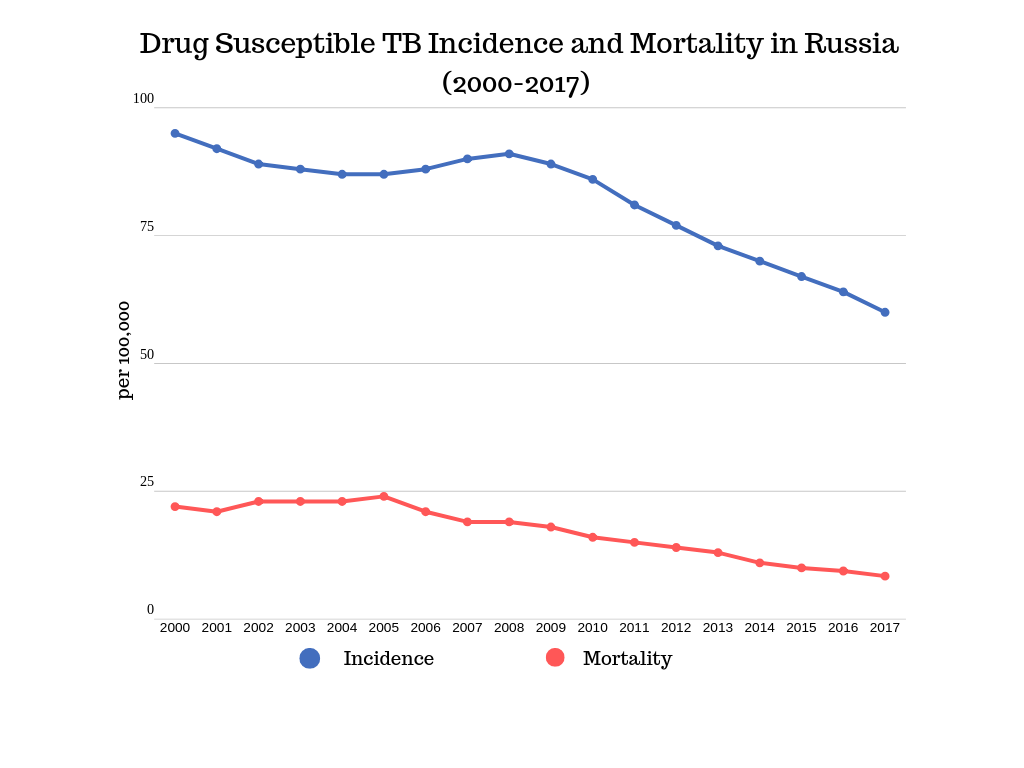
Russia’s international activism on NCDs and TB sends a deliberate, unmistakable message: Respect us. We are now a valued convening power for high-level dialogues on global health priorities. Stop sending experts and consultants to tell us what to do, as if we were a developing country. We have important, compelling experience and expertise at home that can be rightly showcased as a model for others. We are less hamstrung by the commercial interests in the pharmaceutical, food, beverage, and tobacco industries that stymie progress in the West on the NCD agenda. We are claiming our rightful place on the global health stage.
Bad Practices Spoil the Upbeat Story
There is a flip side to this coin. In several key areas, Russia has pursued policies of benign neglect. In others, it has imposed a malignant intransigence, with both domestic and international ramifications.
Tuberculosis
Despite its impressive recent progress on drug susceptible TB control, social, institutional, financial, and biological factors have pushed Russia to the third highest rate of DR-TB in the world—and climbing.[^8] As of 2017, new Russian TB cases that are drug resistant stand at 32 percent. Even after two decades of reform, there remain disturbing gaps between WHO TB guidelines and Russian practice, including mass screenings, outdated reliance on surgery, inadequate guidelines on DR-TB, and a failure to fully adopt people-centered (as opposed to hospital-centered) care.[^9] Nosocomial infections—diseases transmitted inside health facilities—are a persistent problem, with TB patients coming into the hospital with one TB strain and departing with another. In aggregate, these practices are a colossal drag on economic productivity. Russia’s economy lost $1.2 billion due to work absences for treatment of DR-TB in 2018, as current protocols hospitalize patients for an average of seven months. The Institute for Health Metrics and Evaluation (IHME) estimates $3 billion in losses to Russian GDP from 2017 DR-TB mortality alone.[^10]
Figure 4[^11]
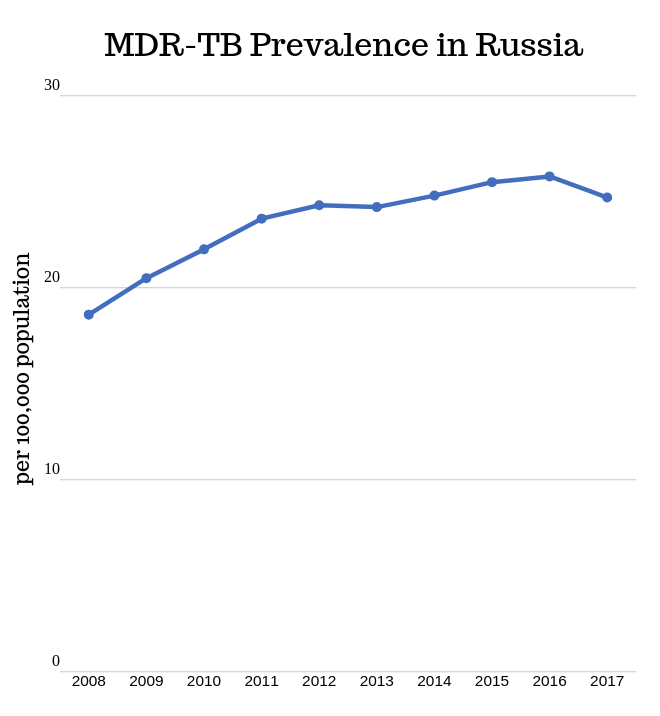
HIV/AIDS
For much of the last decade, Russia has been one of the few places in the world where the HIV epidemic has accelerated. The number of people living with HIV (PLHIV) in the country crossed the million mark in early 2017, and the Russian Federal AIDS Center estimates that the number of newly diagnosed infections reached just over 100,000 in each of the last three years (2016-2018).[^12] According to UNAIDS, Russia accounted for 71 percent of the new infections in Eastern Europe and Central Asia in 2018, driving the region’s 29 percent increase from 2010 to 2018.[^13]
Figure 5[^14]
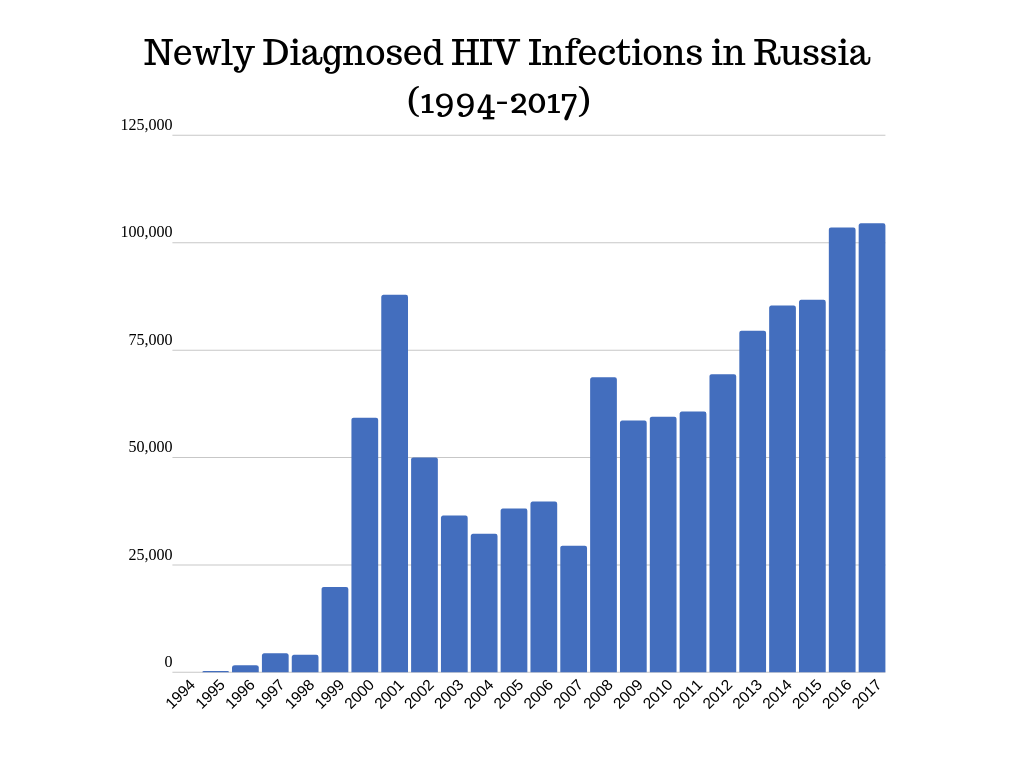
The potential internal consequences are severe: almost 80 percent of Russia’s HIV cases are in just 20 of its 85 regions, and those 20 are its most populous and industrially developed, representing about three-quarters of the country’s economy.[^15] Visibility into the true HIV situation is gravely limited. Screening covers only about 20 percent of the population each year, while key populations—people who inject drugs, sex workers, men who have sex with men (MSM)—are not reached at even that modest level.[^16] And testing frequently occurs far too late. In 2014, about 40 percent of people newly diagnosed had CD4 (white blood cell) counts below 350—a signal of severe, undertreated HIV illness.[^17]
AIDS-related mortality is still relatively low, but it is not likely that will be true for long. Official 2017 data on Russia’s progress toward the UNAIDS “90-90-90” targets are disturbing: only 81 rather than the targeted 90 percent of people living with HIV knew their HIV status; 45 rather than the targeted 90 percent of those diagnosed with HIV were on sustained antiretroviral treatment; and 75 rather than the targeted 90 percent of those receiving antiretroviral therapy had achieved viral suppression.[^18] If we do the math with these official statistics, only 27 percent of the over one million persons living with HIV have successfully reached the point where their infection is suppressed and they are no longer able to pass on the virus. Worse still, even these numbers are widely suspect, both within and outside of the Russian government. UNAIDS estimates that official Russia data underestimates the prevalence of HIV by as many as 600,000 to 900,000 people.[^19]
Figure 6[^20]

Availability of high-quality HIV treatment is held hostage to broader Russian ambitions around import substitution in the pharmaceutical industry. Since 2012, use of daily oral pre-exposure prophylaxis (PrEP) has become a safe, effective HIV prevention tool recognized as a global priority. Russia legalized PrEP in the fall of 2018, but the first Russian production of Truvada, under license with Gilead Sciences Inc., has not yet begun.[^21] Prevention services involving education, behavior change, and harm reduction—backed by the international community in concert with then-thriving homegrown NGOs—are now close to nil. The U.S. President’s Emergency Plan for AIDS Relief (PEPFAR) supported these priorities until 2012, when Department of State and USAID programs were abruptly evicted by the Kremlin, and Russia’s final Global Fund HIV grant closed in 2018.[^22]
Marginalized Populations
In any society, the heaviest lift but greatest impact on TB and HIV comes in reaching the most stigmatized, vulnerable populations: prisoners and former prisoners, sex workers, urban slum dwellers, people who inject drugs, migrants, men who have sex with men, and transgender persons. Russia’s political system, its culture, and its law enforcement, suffused with stigma and denial, are not only woefully unequipped to deal with the difficult challenges involving marginalized groups, but they systematically disregard—indeed openly reject—these populations. Government ministers in Russia’s patronage-driven kleptocracy keep their jobs and win promotions by claiming success and by reporting good news. Outside the health sector, TB and HIV are bad news stories, with which most officials want no affiliation.
Russia’s siloed, medicalized approach to TB and HIV neglects the social determinants of disease. Its health system has made tremendous progress with diagnostics, treatment, and procurement, but many people fall through the cracks of that system. These people are diagnosed too late, improperly, or not at all; they don’t return for treatment; or their treatment is inadequate or improper.
Russia’s treatment of addiction as a criminal justice issue, rather than a health issue, is a death sentence for thousands of people who inject drugs. They have few places to turn for humane, effective treatment. Russian policy and law are overtly hostile to needle and syringe programs, neither of which is available in prisons, which remain prime incubators for TB and HIV. Likewise, opioid agonist therapy (OAT) is stubbornly, aggressively, and proudly banned. The Russian government’s entrenched narrative, in the face of all evidence and internationally accepted best practices to the contrary, holds that methadone and buprenorphine just replace one addiction with another. Nearly 14,000 Crimeans were impacted by the sudden cutoff of harm reduction and treatment programs after the annexation in 2014. The United Nations reports that as many as 120 OAT patients died from suicide, narcotics overdoses, or complications of HIV or tuberculosis soon after the jurisdictional change.[^23]
On balance, Russia’s combative stance on harm reduction undermines the strength of any claim to be a credible global health leader. Its behavior and practices amount to disruption by design. Its export of cultural and health practices and policy, backed in some cases by outright intimidation (particularly in Central Asia), carry regional and global implications. High numbers of migrants from Central Asia and Eastern Europe who enter Russia are exposed to injection drug use, commercial sex, HIV, and TB but with no access to screening or harm reduction and treatment services. Without access to these services, migrants may be at increased risk for undiagnosed infectious disease. Several neighboring states—most notably Ukraine, Georgia, Moldova, and Kazakhstan—have deliberately and conspicuously struck out on their own path, defying Moscow and aligning themselves geopolitically and in terms of public health with the West.
What Is Washington to Make of All of This?
There is a need for both fairness and sober realism in judging the value of Russia’s expanded engagement in global health, what that means for U.S. policy, and how the United States should respond. The first impulse is to blanch at Russia’s new global health enterprise, given the stark landscape of its broader bad behavior. The international community should not, however, reject Russia’s overtures altogether. We should encourage and support Russia’s meaningful contributions to shared goals.
Unquestionably, Russia has advanced the global agenda on TB and NCDs. Its diplomatic leadership and investments in WHO capacities have been largely welcomed and do not, in any serious way, conflict with U.S. interests. Russia’s external activism flows logically from the fact that TB and NCDs are viewed as essential to Russia’s sovereign health security interests, reflected in the Russian government’s framing of its demographic and health challenges as national security priorities.[^24]
The United States should not attempt to wall off Russia or call for its isolation on health issues. Quite the contrary, it should leave the door open for U.S.-Russia dialogue on shared global health concerns. Along these same lines, there is no reason that the United States should not continue to actively support those respected Russian experts now in important international leadership positions at WHO and other international bodies. That should include serving together on international technical committees and exchanges and continuing to support the greatly diminished set of research and development collaborations inside Russia (particularly in large cities such as St. Petersburg and Kazan), as well as the limited number of endangered civil society groups still able to function. After all, the Russian health care and medical professionals who remain engaged with Western partners are likely to form the cornerstone of any meaningful policy change in their country moving forward. The United States should do what it can to strengthen their hand.
At all points, however, our eyes should remain wide open. When placed in the broader geopolitical context, Russia’s contribution remains inherently contradictory and constrained. Global health does not occupy a position of true high priority for Russia’s leadership. Health is a tool, subordinate to politics, and not an end in its own right. Russia struggles with limited financing, a shallow bench of skilled personnel, weak institutional capacities, and few allies, including its own regional neighbors. Its enduring siloed approaches, a legacy of the Soviet era, continue to hobble policies and progress. Its deliberately disruptive stances on HIV and its disregard for the sociocultural factors driving TB greatly limit the legitimacy and effectiveness of its international activism. Russia’s harsh critique of liberal internationalism, including attacks on permissiveness (versus personal responsibility) in combatting addiction, are self-serving and contradictory to its hope of getting a seat at the global health table, even while these arguments resonate among many non-Western leaders and publics, requiring a better retort from the West. Russia continues to make counterproductive claims, like its alleged advancements in Ebola vaccine development. Its online bots and trolls pollute social media, spreading disinformation and confusion and undermining popular trust and confidence in vaccines and other preventive health measures. Most importantly, Russia’s contributions to NCDs and TB are eclipsed by the battery of its aggressive behavior: its active assault upon U.S. and others’ democratic institutions and alliances, its occupation of Ukrainian territory and populations, and its use of nerve agents, to name but the most prominent examples.
What’s the United States to Do?
Washington should turn its attention actively to building a health security alliance, with HIV/AIDS, TB, and health security capacities at its center, among key partners in Eastern Europe and Central Asia. A foundation of strong public health collaborations already links the United States with Ukraine, Georgia, and Kazakhstan, among others. That foundation could be readily enlarged to encompass other countries from across the post-communist space, collaborating with Russia where feasible and appropriate but also countering harmful Russian influence where necessary with evidence-based policy dialogue, technical assistance, and material support.
Such an initiative should focus on four key areas as part of an integrated approach that draws on existing multilateral and U.S. government capacities, while aligning with the global universal health coverage (UHC) agenda. It can and should be carried out in active partnership with WHO, the World Bank, Germany, Scandinavian countries, the United Kingdom, and the European Union.
First, the Global Health Security Agenda (GHSA), whose work focuses in low- and middle-income countries on building capacity to prevent, detect, and respond to human and animal infectious disease outbreaks, should expand to include Eastern Europe and Central Asia. That would build on existing momentum in the region—11 countries have already completed or are in the process of completing Joint External Evaluations (JEEs) to assess their own capacities under the International Heath Regulations (IHR).
Second, the United States should expand the PEPFAR program beyond the successes achieved in Ukraine and the regional program in Eastern Europe and Central Asia to address the most acute geographic areas of concern and prevent further resurgence of the HIV epidemic there. Such efforts would directly support prevention and treatment efforts in the region while countering Russian pressure on its neighbors to adopt anti-harm reduction policies that could reverse hard-won gains.
Third, the National Institutes of Health (NIH) should broaden and deepen research alliances with investigators based out of academic, research, and civil society groups in Eastern Europe and Central Asia working to address HIV and TB.[^25] Additionally, NIH should support research and development opportunities that track with U.S. infectious disease priorities, such as medical countermeasures for emerging pathogens.
Fourth, the United States could center Eastern Europe and Central Asia as part of an enhanced effort to educate and shield both itself and its allies from Russian penetration of social media networks and the broader information space related to health. This initiative—which would clearly extend beyond the public health sphere to involve intelligence agencies, the military, and other entities—could strategically combat the deliberate channels of Russia-sourced misinformation that are contributing to escalating outbreaks of measles and other vaccine-preventable diseases across Europe and Eurasia and in the United States.
Pursuit of this upgraded health security alliance is not risk-free. Russia may interpret deeper engagement by the United States as direct encroachment into its “sphere of influence.” Even beyond Russian rancor, geopolitical competition for influence over the region is complex and increasingly crowded, with China, Iran, Saudi Arabia, and others vying for position to shape what happens there. Special care will be needed to engage Russian partners where appropriate, align U.S efforts with key Western European and multilateral stakeholders, and expand the playbook to include other participants where U.S. and Russian interests align.
The potential rewards—including improved health outcomes—are worth the effort. The time is ripe for the United States to align its global health security priorities with Eastern Europe and Central Asia. The United States, through USAID and other agencies, has already invested considerable taxpayer resources on health priorities in these regions. Ceding this space now to Russia or other players imperils those achievements. Countries in these regions are at risk of becoming a major new global front in the HIV and TB epidemics. They are under intense pressure from Russia and open to expanded partnership with the United States. These governments seek to upgrade their public health systems, embrace evidence-based WHO guidelines, and demonstrate their autonomy and independence. What they require now is a signal of serious U.S. intent: to support their efforts to win public health independence and increased capacity, acknowledging and absorbing the best of what Russia has to offer, but armed with the tools to rebuff the malign elements of Russian interference and deliberate destabilization.
This commentary is a product of the CSIS Commission on Strengthening America’s Health Security, generously supported by the Bill & Melinda Gates Foundation.
**Commentary is produced by the Center for Strategic and International Studies (CSIS), a private, tax-exempt institution focusing on international public policy issues. Its research is nonpartisan and nonproprietary. CSIS does not take specific policy positions. Accordingly, all views, positions, and conclusions expressed in this publication should be understood to be solely those of the author(s).
© 2020 by the Center for Strategic and International Studies. All rights reserved.**
[^1]: Global Burden of Disease 2016 Russia Collaborators, “The Burden of Disease from 1980 to 2016: A Systematic Analysis for the Global Burden of Disease Study 2016,” The Lancet 392 (September 2018); A. Kontsevaya et al.,“How Has the Management of Acute Coronary Syndrome Changed in the Russian Federation during the Last Ten Years?” Health Policy 121, no. 12 (2017): 1274-1279.
[^2]: “UN Interagency Task Force on NCDs (UNIATF) : Meetings and Events,” World Health Organization, 2019, https://www.who.int/ncds/un-task-force/en/
[^3]: “Global TB Programme,” World Health Organization, 2019, https://www.who.int/tb/en/
[^4]: “WHO Independent High-level Commission on NCDs,” World Health Organization, 2019, https://www.who.int/ncds/governance/high-level-commission/en/
[^5]: “UN Interagency Task Force on NCDs (UNIATF): Country Missions,” World Health Organization, 2019, https://www.who.int/ncds/un-task-force/en/
[^6]: “Tuberculosis Surveillance and Monitoring in Europe: The Russian Federation,” World Health Organization, 2016, http://www.euro.who.int/__data/assets/pdf_file/0018/310806/TB-surveillance-report-2016-The-Russian-Federation.pdf
[^7]: “Global Tuberculosis Database,” World Health Organization, 2019, https://www.who.int/tb/data/en/
[^8]: Jon Cohen, “Drug-Resistant Tuberculosis Strains Gain Foothold in Russia,” Science Magazine, May 19, 2017, http://www.sciencemag.org/news/2017/05/drug-resistant-tuberculosis-strains-gain-foothold-russia
[^9]: A. Odone et al., “People and Patient-Centered Care for Tuberculosis: Models of Care for Tuberculosis,” InternationalJournal of Tuberculosis and Lung Disease 22, no. 2 (February 2018): 133-138.
[^10]: Economist Intelligence Unit, It’s Time To End Drug-Resistant Tuberculosis: The Case for Action (London: 2019), https://www.eiu.com/graphics/marketing/pdf/its-time-to-end-drug-resistant-tuberculosis-full-report.pdf
[^11]: “Tuberculosis Indicators in the Russian Federation,” 2019, Federal Center for Tuberculosis Control, http://old.mednet.ru/ru/czentr-monitoringa-tuberkuleza.html
[^12]: Robert Heimer, “The Policy-Driven HIV Epidemic among Opioid Users in the Russian Federation,” Current HIV/AIDS Reports15, no. 3 (June 2018): 259-265.
[^13]: UNAIDS, Communities at the Centre (Geneva: July 2016), 8, https://www.unaids.org/en/resources/documents/2019/2019-global-AIDS-update
[^14]: “Справка ВИЧ-инфекция в Российской Федерации в 2017 г’” (“Help HIV in the Russian Federation in 2017”), 2017, RussianFederal AIDS Center, http://aids-centr.perm.ru/images/4/hiv_in_russia/hiv_in_rf_31.12.2017.pdf
[^15]: Alex Gatenby and Roland Oliphant, “Viral Tide: How Russia Became the New Front Line in the War on HIV/AIDS,” The Telegraph, December 1, 2018, https://www.telegraph.co.uk/global-health/science-and-disease/viral-tide-russia-became-new-frontline-war-hivaids/
[^16]: Judyth Twigg, “Russia’s Avoidable Epidemic of HIV/AIDS,” PONARS Eurasia, PONARS Policy Memo 581, March 2019, http://www.ponarseurasia.org/memo/russias-avoidable-epidemic-hivaids
[^17]: “HIV/AIDS in Russia,” AVERT, https://www.avert.org/professionals/hiv-around-world/eastern-europe-central-asia/russia
[^18]: “Russian Federation Commits To Reach 75% Antiretroviral Therapy Coverage in 2019,” UNAIDS, September 12, 2018, https://www.unaids.org/en/resources/presscentre/featurestories/2018/september/russian-minister-health-90-90-90
[^19]: Jon Cohen, “Russia’s HIV/AIDS Epidemic is Getting Worse, Not Better,” Science Magazine, June 11, 2018, https://www.sciencemag.org/news/2018/06/russia-s-hivaids-epidemic-getting-worse-not-better
[^20]: “Russian Federation Commits To Reach 75% Antiretroviral Therapy Coverage in 2019,” UNAIDS, September 12, 2018, https://www.unaids.org/en/resources/presscentre/featurestories/2018/september/russian-minister-health-90-90-90
[^21]: Jon Cohen, “Russia’s HIV/AIDS Epidemic is Getting Worse, Not Better,” Science Magazine, June 11, 2018, https://www.sciencemag.org/news/2018/06/russia-s-hivaids-epidemic-getting-worse-not-better
[^22]: “Why USAID is Leaving Russia,” Carnegie Endowment for International Peace, September 20, 2012, https://carnegieendowment.org/2012/09/20/why-usaid-is-leaving-russia-pub-49444
[^23]: Madeline Roache, “Russia’s Methadone Ban Is Fueling An HIV Epidemic in Crimea,” Moscow Times, November 11, 2017, https://www.themoscowtimes.com/2017/11/11/russias-methadone-ban-is-fueling-a-hiv-a59488
[^24]: Government of Russia, “National Security Concept of the Russian Federation,” Presidential Decree No. 1300, December 17, 1999, https://fas.org/nuke/guide/russia/doctrine/gazeta012400.htm
[^25]: See the National Institutes of Health Fogarty International Center’s database of global biomedical researchcollaborations: https://worldreport.nih.gov